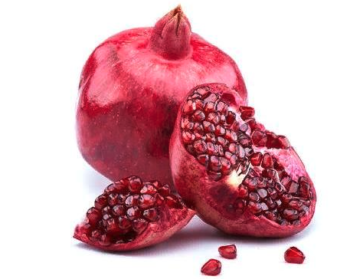Useful properties of pomegranate
A bit of history
The pomegranate, whose beneficial properties were noticed in antiquity, was cultivated several thousand years ago. The height of the tree reaches 10 m, the leaves are leathery dark green, the flowers are bright red, the fruits are large up to 1 lb. The pomegranate fruit has a spherical shape of yellow-red color, the peel is thick, leathery, and astringent in taste. Inside there are 6 to 12 nests, which are separated by a membrane septum, and in the nests there are many seeds. The seeds are angular and surrounded by juicy pulp that forms from the seed coat.
The homeland of such a marvelous fruit of India is Iran, Afghanistan, Azerbaijan and the neighboring countries of the state. Many different varieties have been bred over the centuries. It is historically proven that pomegranate spread across all continents in the period of the 16th – 17th centuries.
The Greeks considered fruits to be a symbol of a happy marriage, and in Central Asia, pomegranates were a symbol of good relations and friendship.
The fruit got its name “Punica granatum” from the ancient Romans and Greeks. Since it came from the Punyans), the Greeks also called it “pomegranate”, which in translation is grainy.
The composition of a very tasty and healthy fruit
The pulp of the fruit contains fructose, malic and citric acids, is rich in micro-, macro- and ultra microelements, vitamin C, provitamin A, flavonoids and anthocyanins. The fruits collected from the branches can lie until spring, retaining all the beneficial properties.
Pomegranate juice contains 8-10% sugar, some varieties boast organic acids (citric, malic), nitrogenous substances, phytoncides, vitamin C, potassium, magnesium, calcium, sodium, phosphorus, manganese.
The peel and roots contain alkaloids, the beneficial properties have a anthelmintic effect.
So what are the beneficial properties of pomegranates?
The juice was used even before our era to relieve stomach pain. It is also used for colds, sore throat and lack of voice.
Another useful property is the ability to increase the hemoglobin content in the blood. The course of treatment is 2 – 4 months. 100-200 ml of pomegranate juice is taken before meals 3 times a day. After that, a break of 1 month, and the treatment can be continued again. In this case, you should adhere to a diet. Regular consumption of pomegranates lowers blood pressure, but remember that the fruit is astringent and sometimes constipated.
You can also increase the level of hemoglobin by drinking 100 ml of a mixture of pomegranate, grapefruit, lemon, carrots, apples, honey and beets 3 times a day before meals.
The juice is also used for cosmetic purposes: it whitens the skin of the face, removes age spots, acne and freckles. The mask of pomegranate juice and sour cream is very nutritious and useful. It not only promotes whitening, but also nourishes the skin.
One of the beneficial properties of this fruit is a tonic effect that affects the digestive system and the absorption of food intake. In addition, it can be considered as a biogenic stimulant for the treatment of diseases of the pancreas.
Doctors recommend taking juice in case of gastrointestinal tract disorders, after operations and postponed infectious diseases as a general tonic.
Syrups, refreshing drinks and extracts are made from pomegranate nectar. For many centuries, mankind has known its beneficial properties. Hippocrates, Avicenna, Galen in their writings recommend the use of pomegranate for medicinal purposes: for diseases of the gastrointestinal tract, throat, colds, fever, headaches and as an anthelmintic agent.
Pomegranate peel contains tannins and is effective in treating intestinal disorders and also is used against tapeworms. And its broth will help to get rid of dandruff and improve hair growth.
Women during menopause can use not only the pulp, but also the seeds of the fruit, as they contain fatty oils that normalize hormonal processes in the body, have an analgesic effect, reduce blood pressure and relieve irritability.
The peel of the fruit contains up to 30% tannins, treats dysentery and intestinal disorders. Folk recipes recommend using pomegranate together with the peel for bronchitis, inflammation of the colon, colds, malaria, etc. Strict dosage is required: no more than 3-4 times a day, a teaspoon.
As a fortifying agent, you can use a decoction of 5 g of peel and 100 ml of water. Take 0.5 – 1 tsp. 3 times a day. You can improve the taste by replacing the water with syrup and adding a little dry wine.
Syrup for removing tapeworm from the body: 50 g of pomegranate seeds are soaked for 6 hours in 400 ml of water, after which the mixture is placed on the stove and boiled until the solution is halved. The broth is filtered through cheesecloth or a fine sieve and gradually drinks over an hour, preferably in the morning on an empty stomach. After 2 – 3 hours, laxatives are taken (castor oil or Glauber’s salt).
A few more tasty and healthy recipes
Pomegranate juice is used to prepare delicious nasharabi sauce, which is one of the best additions to Caucasian dishes. Freshly squeezed juice is poured into a container and boiled 3 times the original volume. Then it is poured into a glass dish and cooled. This sauce will add a unique piquancy to the dish.
Pomegranate sauce with nuts. For 200 ml of pomegranate juice, 50 grams of walnuts, a garlic clove, a little fresh cilantro and hot chili pepper (to taste) are taken. The juice is diluted with drinking cold water (about 0.5 cups). Nuts, peppers, garlic and cilantro are mixed and passed through a meat grinder. The resulting mixture is added to the juice and salted to taste.
An unusual snack. You will need 8 eggplants, a small onion, 50 grams of walnuts, a half of a glass of pomegranate seeds, salt and pepper. Peel and chop the eggplants baked in the oven, add pepper, salt, chopped onions, walnuts (crushed) and pomegranate seeds. All this is completely mixed. A delicious and healthy salad is ready. It is best served chilled.










